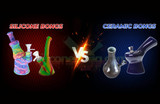How to Clean a Silicone Nectar Collector
More people are trading in their more complex rig setups and grabbing a nectar collector, which offers a much more user-friendly way to enjoy concentrates. Nectar collectors are portable, relatively simple in design and fully capable of delivering smooth, flavorful, and impressively potent vapor to the user. A huge trend we are seeing is that of silicone nectar collectors. Silicone material in general is shatterproof and fully capable of withstanding the heat involved during the dabbing process. Not only that, but a silicone nectar collector can provide you with endless dabbing satisfaction. However, if you’re working with a dirty piece, you can only enjoy that vapor so much.
How Important is it to Have a Clean Silicone Nectar Collector?
Many dabbers seriously underestimate the importance of this component of maintenance, but ultimately at their own expense. When working with a nectar collector that hasn’t been cleaned in a while, you are likely going to encounter less-than-ideal flavor and, in more extreme cases, some level of airflow interference. That is because when we dab, the vapor carrying the compounds slowly develops a layer of film or buildup along the interior of the device, combined with the water itself getting dirty.
How Often Then Should You Clean a Silicone Nectar Collector?
Ultimately, the best way to enjoy a clean nectar collector is to undergo a cleaning process after each use. While this may sound tedious, if you do clean it after each use, the actual cleaning process will be much faster and easier. Waiting too long in between cleaning sessions is when you have to work harder to remove all of that buildup that accumulates over time.
If cleaning it after each use is more than you can commit to, then consider cleaning it after every third or fourth use, which may end up coming out to about once a week or twice a week.
Silicone vs. Glass: Which is Easier to Clean?
The process for cleaning a nectar collector is essentially the same, regardless of whether or not the device is made from glass or silicone. Still, many people do find that cleaning a silicone device is easier than cleaning a glass one, primarily because the silicone’s surface is smoother and therefore buildup wipes off more easily.
What is the Proper Way to Clean Your Silicone Nectar Collector?
Cleaning a nectar collector is fortunately easy to clean, especially if you clean it on a schedule. And, at SiliconeBong.com, we offer all of the cleaning supplies that you need to keep your nectar collector free of gunk and film at all times.
Step #1: Dissemble your silicone nectar collector carefully. Make sure to only take apart the components that are meant to be taken apart, rather than trying to break open pieces that are supposed to stay intact.
Step #2: Now, you can get to work. First, you’ll need a cleaning solution. You can make your own using isopropyl alcohol, salt, and water, or you can find plenty of cleaning solutions made especially for these types of devices available on our website. Either place all of the pieces into some type of bowl or basin and allow them to soak by weighing them down with a heavier object that is in your kitchen, or simply use cleaning plugs made especially for these types of devices to plug up the ends and keep the solution within each piece.
Step #3: If you can allow the pieces of your nectar collector to soak in the solution overnight, that is ideal. If you cannot, 2 hours is suitable. The longer the pieces soak, the more easily any film will come off as the solution breaks up any buildup.
Step #4: Once the pieces are done soaking, use a pipe cleaner to remove any buildup that’s still there.
Step #5: Give each piece a good rinse and allow it to air-dry. Then, you can put the nectar collector back together.
Can You Clean a Silicone Nectar Collector in the Dishwasher?
Silicone is a heat-resistant material that maintains its shape easily and doesn’t retain heat. So, you can technically wash the silicone components in the dishwasher, as well as the tip as long as it’s made from quartz. Just keep in mind that after a dishwasher cycle, you may still need to use a pipe cleaner to dislodge any remaining residue, and then follow that up with a rinse.
The reason why a dishwasher cleaning session is not our first choice is because sometimes it can dehydrate the film that is along the interior of the device during the drying cycle, if the buildup is advanced enough. This would mean that you might need to soak it later on anyway, which actually make it harder to clean; then allowing it to soak and become more hydrated. If you’re in a hurry though, it’s definitely better than nothing.
What to Avoid
Now that you know how you can clean a nectar collector, let’s quickly cover two main things that you shouldn’t do.
#1: Unsafe Cleaning Products
Examples include bleach, window cleaner and most general household cleaners used for different surfaces. These products contain chemicals that can be detrimental to your health if inhaled. Even if you think you rinsed out the product completely, trace amounts can linger, and when heated to the temperatures involved when dabbing, can become carcinogenic.
#2: Abrasive Cleaning Materials
While silicone is overall a highly resilient material, some abrasive cleaning materials can cause tiny tears in the material which can accumulate residue and become harder to clean. Basically, we do not recommend using abrasive materials to clean your nectar collector, like steel scrubbing pads.
Recent Posts
-
Top 5 Best Silicone Reclaim Catchers for Dab Rigs
Top 5 Best Silicone Reclaim Catchers for Dab RigsReclaim catchers are a must have for anyone using a …Mar 29, 2022 -
Silicone Bongs vs. Ceramic Bongs
Most of us once believed that the only type of bong material was glass, and that’s understandable …Aug 16, 2021 -
Are Silicone Bongs Worth it?
Did you know that more bong enthusiasts are switching out their glass pieces for water pipes made …Aug 09, 2021


